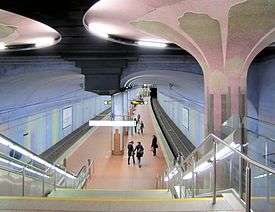Frankfurt U-Bahn
 | |||
|
Underground station Westend on Lines U6 & U7. | |||
| Overview | |||
|---|---|---|---|
| Owner | RMV | ||
| Locale | Frankfurt am Main, Hesse, Germany | ||
| Transit type | Rapid transit/Light rail[1] | ||
| Number of lines | 9[2] | ||
| Number of stations | 86[2] | ||
| Daily ridership | 321,000 (2012)[2] | ||
| Annual ridership | 117.3 million (2012)[2] | ||
| Website | VGF | ||
| Operation | |||
| Began operation | 4 October 1968[3] | ||
| Operator(s) | Verkehrsgesellschaft Frankfurt (VgF) | ||
| Character | Mostly underground, with significant sections at-grade (including at-grade intersections), with some street running (U5 line) | ||
| Train length | 50–105 metres (164–344 ft) | ||
| Headway | 5-15 minutes (daytime) | ||
| Technical | |||
| System length | 64.9 km (40.3 mi)[2] | ||
| Track gauge |
1,435 mm (4 ft 8 1⁄2 in) (standard gauge) | ||
| Top speed | 80 km/h (50 mph) | ||
| |||
The Frankfurt U-Bahn, together with the Rhine-Main S-Bahn and the Frankfurt Straßenbahn, forms the backbone of the public transport system of Frankfurt, Hesse, Germany. Its name derives from the German term for underground, Untergrundbahn. Since 1996, the U-Bahn has been owned and operated by Verkehrsgesellschaft Frankfurt (VgF), the public transport company of Frankfurt, and is part of the Rhein-Main-Verkehrsverbund (RMV) transit association.
The U-Bahn opened in 1968,[3] and has been expanded several times. It consists of three inner-city tunnels and above-ground lines in the suburbs. About 59% of the track length is underground. The above-ground sections operate at different standards from traditional rapid transit systems due to the independent expansion of at-grade rail for those sections – they are more like light rail[1] (Stadtbahn) due to their not being fully grade-separated.[4]
The network consists of 86 stations on nine lines, with a total length of 64.85 kilometres (40.30 mi).[2] Eight of the nine lines travel through the city center (line U9 being the exception). In 2012, the U-Bahn carried 117.3 million passengers,[2] an average of approximately 321,000 passengers per day.
History
Planning began in the 1950s to replace the overburdened streetcars with a more robust public transit system. The various local political parties put forward plans for a full U-Bahn, a streetcar system with an underground section downtown (i.e. a Stadtbahn), and an elevated railway, respectively. Eventually politics, in the form of the 1964 municipal election, resolved the issue in favor of the U-Bahn project that began as a light rail/Stadtbahn network using tunnels in Frankfurt's city core, but which in the future would be transformed into a fully rapid transit U-Bahn network.
The U-Bahn opened on 4 October 1968, with the underground route from Hauptwache to Nordweststadt.[3]
Current routes
The U-Bahn consists of nine lines, U1 to U9, running on three primary routes based on the three tunnels, with a planned fourth route from the suburbs to the Frankfurt Hauptbahnhof only partially completed:
| Route | Line | Path | Stations |
|---|---|---|---|
| A (and D) |
|
Ginnheim - Römerstadt - Nordwestzentrum - Hauptwache - Willy-Brandt-Platz - Südbahnhof | 20 |
| A | |
Bad Homburg-Gonzenheim - Ober-Eschbach - Nieder-Eschbach - Bonames - Hauptwache - Willy-Brandt-Platz - Südbahnhof | 21 |
| A | |
Oberursel-Hohemark - Oberursel - Niederursel - Hauptwache - Willy-Brandt-Platz - Südbahnhof | 28 |
| B (and C+D) |
|
Enkheim - Schäfflestraße - Seckbacher Landstraße - Bornheim - Konstablerwache - Willy-Brandt-Platz - Hauptbahnhof - Festhalle/Messe - Bockenheimer Warte | 15 |
| B | |
Preungesheim - Eckenheim - Hauptfriedhof - Konstablerwache - Willy-Brandt-Platz - Hauptbahnhof | 16 |
| C | |
Heerstraße - Bockenheimer Warte - Hauptwache - Konstablerwache - Ostbahnhof |
15 |
| C | |
Hausen - Bockenheimer Warte - Hauptwache - Konstablerwache - Eissporthalle - Hessen-Center - Enkheim |
20 |
| A (and D) |
|
Riedberg - Niederursel - Hauptwache - Willy-Brandt-Platz - Südbahnhof | 19 |
| D (and A) |
|
Nieder-Eschbach - Riedberg - Niederursel - Nordwestzentrum - Römerstadt - Ginnheim | 12 |

Rolling stock
- U1 Class (1966–76)
- U2 Class (1968–2016)
- U3 Class (1980–present) – Deployed on U6
- U4 Class (1994–present) – Deployed on U1–U3, U8 & U9
- U5 Class (2009–present) – Deployed on U1–U4, U6–U9
- Pt Class (1979–present) – Tramcars, deployed on U5
See also
- Rhine-Main S-Bahn (Frankfurt)
- Trams in Frankfurt am Main
- Public transport in Frankfurt am Main
- List of rapid transit systems
References
- 1 2 Taplin, Michael (March 2013). "Home > World Systems List index > World List F-J - Germany (DE)". Light Rail Transit Association (LRTA). Retrieved 2014-07-27.
- 1 2 3 4 5 6 7 "ZAHLENSPIEGEL 2012" [STATISTICS 2012] (PDF) (in German). vgF. December 31, 2012. Retrieved 2013-09-29.
- 1 2 3 "History - The history of local public passenger transport in Frankfurt". vgF. Retrieved 2013-09-29.
- ↑ Schwandl, Robert. "FRANKFURT am Main". UrbanRail.net. Retrieved 2014-07-27.
The Frankfurt "U-Bahn" is not a real metro, but rather a typical German Stadtbahn (like that of Stuttgart, Dortmund or Hanover), i.e. some sections in the city centre were built to full metro standards, whereas others along outer sections have level crossings, in the case of line U5 even some on-street running.
- German
- Jens Krakies, Frank Nagel, Stadt Frankfurt am Main (Hrsg.): Stadtbahn Frankfurt am Main: Eine Dokumentation. 2. Auflage. Frankfurt am Main 1989, ISBN 3-923907-03-6, S. 23–42. (Standardwerk zur U-Bahn und ihrer Baugeschichte)
- Dieter Höltge, Günter H. Köhler: Straßen- und Stadtbahnen in Deutschland. 2. Auflage. 1: Hessen, EK-Verlag, Freiburg 1992, ISBN 3-88255-335-9, S. 23–42. (Alle ehemaligen und bestehenden Straßenbahnbetriebe in Hessen, außerdem ein Kapitel zur Frankfurter U-Bahn, die 2. Auflage besitzt einen Anhang mit Aktualisierungen)
- Hans-Werner Schleife, Günter Götz: Lexikon Metros der Welt. Geschichte, Technik, Betrieb. transpress, Berlin/Stuttgart 1985. ISBN 3-613-01068-2 (101 U-Bahn-Betriebe der Welt, einschl. Beschreibung des Frankfurter Betriebs)
- Walter Söhnlein, Jürgen Leindecker: Die Frankfurter Lokalbahn und ihre Elektrischen Taunusbahnen. GeraMond, München 2000. ISBN 3-932785-04-5 (Die U-Bahn ist nicht zentraler Gegenstand des Buches, als Nachfolgerin der Lokalbahnstrecken wird die Entwicklung der A-Strecken jedoch ausführlich beschrieben)
- Thomas Hanna-Daoud (Red.): Nahverkehr in Frankfurt. Trambahn, U-Bahn, S-Bahn, Omnibus, Eisenbahn. Strassenbahn-Nahverkehr special. Nr. 7. GeraMond, München 2000. ISBN 3-89724-010-6 (Sonderheft des bekannten ÖPNV-Magazins zu allen Frankfurter ÖV-Netzen)
- Magistrat der Stadt Frankfurt am Main Stadtbahnbauamt (Hrsg.): Die C-Strecke der U-Bahn Frankfurt am Main. Stadtbahnbauamt, Frankfurt am Main 1986. (Informationen über Planung, Bau und Architektur der C-Strecke in Wort und Bild)
- Stadt Frankfurt am Main (Hrsg.): Gesamtverkehrsplan Frankfurt am Main. Ergebnisbericht 2004 (pdf). (Studie im Auftrag des Stadtplanungsamts zur zukünftigen Entwicklung Frankfurter Verkehrsnetze)
- Stadt Frankfurt am Main (Hrsg.): Inbetriebnahme der U-Bahn. Übergabe der Hauptwache und Eröffnung des Nordwestzentrums. Publizität des Presse- und Informationsamts, Frankfurt am Main 1969.
External links
| Wikimedia Commons has media related to: |
- vgF – official website
- traffiQ Mobilitätsberatung (German)
- Nahverkehr Frankfurt am Main (German)
- Frankfurt am Main at UrbanRail.net





